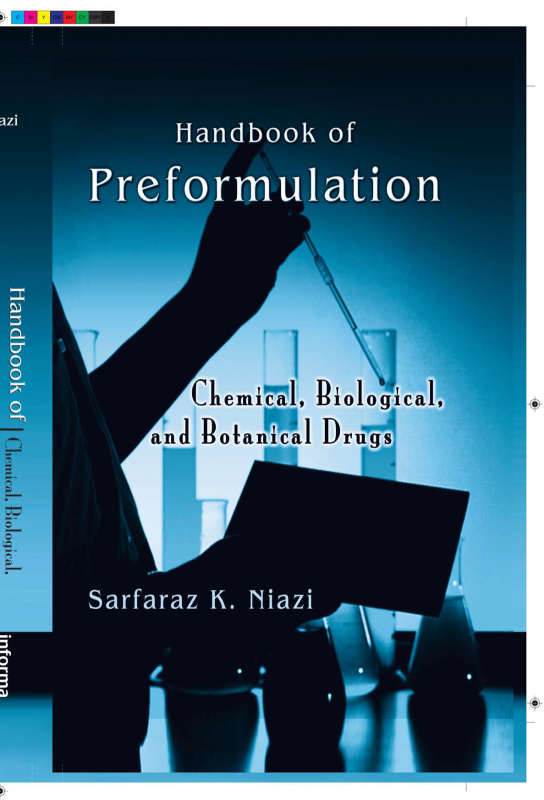Handbook of Preformulation-Chemical, Biological, and Botanical Drugs

Preformulation studies constitute the delicate connection between the two major
groups of scientists: those at the drug discovery end and those at the drug delivery
end. Whereas scientific camaraderie, or perhaps stubbornness, at the two ends of
new drug development has historic roots, it is the preformulation group of comrades
that brings peace to the table. It is often humbling for the drug discovery
group to bring out a novel molecule with remarkable potential only to be shot
down by the formulation group as a worthless exercise in taking it to a deliverable
form. The preformulation group works with both ends and helps reduce the overall
cost and shrink the timeline of drug development. Whereas in some companies the
dividing line between preformulation and formulation is often a gray zone, those
who have understood the significance of keeping the two groups separate have
reaped great rewards. This book is a practical manual for those involved in the preformulation
stages of drug development, yet it would be a good read for the drug
discovery and drug development group as well. The traditional scope of textbooks
and manuals on this topic is expanded here to include biological drugs, particularly
therapeutic proteins and also botanical drugs or phytomedicines. The latter category
is particularly significant as it is fast becoming evident that such regulatory
authorities as the U.S. Food and Drug Administration and European Medicines
Evaluation Agency will start approving them in the same system of approval as
is ordinarily reserved for small- and large-molecule, well-characterized drugs.
The goals of preformulation studies are to choose the correct form of the drug
substance, evaluate its physical and chemical properties, and generate a thorough
understanding of the material’s stability under the conditions that will lead to the
development of a practical drug delivery system. Preformulation is a science that
serves as a big umbrella for the fingerprinting of a drug substance or product
both at the early and latter stage of development in pharmaceutical manufacturing.
The preformulation phase is a critical learning time about candidate drugs. Typically,
it begins during the lead optimization phase and continues through prenomination
and into the early phases of development. Decisions made on the
information generated during this phase can have a profound effect on the subsequent
development of those compounds. Therefore, it is imperative that preformulation
should be performed as carefully as possible to enable rational
decisions to be made. The quantity and quality of the drugs available at this
stage can affect the quality and quantity of data generated—so can the equipment
available and the expertise of the personnel conducting the investigations. In some
companies, there are specialized preformulation teams, but in others the information
is generated by a number of scattered teams. Whichever way a company
chooses to organize its preformulation information gathering, one of the most
important practices to adopt is to keep close communication among the various
groups involved.
The classic definitions and the management systems to conduct preformulation
studies are discussed in the chapters; it would suffice for now to claim that
there is a need to apply the most current knowledge and analytical sophistication
available to deliver these goals. Over the past quarter of a century, the science of
analysis and characterization has taken a giant leap, and so have the options that
are now available to scientists regarding the basic substances as we enter the era
of nano-particles and intelligent delivery designs. A recent study authorized by
the National Security Agency and conducted by Rand Corporation listed nano
and material science to be the leading sciences in the year 2015; this is an important
indication of what is to come and the science of drug discovery will be greatly
affected by it. With new possibilities of materials and systems such as nano
pumps, the evaluation of new drug entities will have to take a different perspective.
Crystalline structure studies form the core of preformulation studies because
molecules make crystals, crystals make particles, and particles make dosage forms.
Novel research in crystallography of new entities involves studies of amorphous
forms to learn how local properties contribute to the chemical reactivity of these
short-interacting forms. Solid solutions are better understood today, and studies
on the effect of different solvents on the formation of solid solutions remain a challenging
opportunity made easy by computer simulation models. Predicting accurate
behavior of amorphous forms will allow great opportunities in drug delivery.
By understanding the effects of various cations and anions on crystal structure
and properties, one can move towards the rational selection of counter-ions for
salt formation and the design of stable salt forms. Neutral pharmaceuticals and excipients
can and do form stable co-crystals. These co-crystals may possess superior
physical properties, such as solubility, melting point, and compaction behavior.
These studies seek to understand the forces that promote the formation of neutral
co-crystals, in particular intermolecular hydrogen bonding. There is an increasingly
strong driving force to predict the properties of a drug in its solid form and this, in
turn, drives the need to predict three-dimensional structure. It is important to
compute all reasonable low-energy conformers from a known chemical structure
and place these conformers into ranked three-dimensional crystal structures.
Studies of how particle shape influences packing properties and how this affects
the translational stress into strain in the tableting process are useful. By studying
such material constants as friction coefficients, Young’s modulus, and viscoelasticity,
one can obtain properties of the bulk powder. This then should be followed
to study polydispersity (in particle size) and to validate the model with X-ray microtomography
of glass powder. The controlled crystallization of organic molecules on
surfaces controls nucleation and deposition of drug crystals of chosen structure as
formed by manipulation of the substrate surface. This provides the groundwork
for the development of self assembled three-dimensional and chemical cage formulations.
The idea is that by controlling the nature of the surface of the substrate,
particular polymorphs may be encouraged to grow. Additionally, the directing
surface may prove to be a way of stabilizing more favorable, but higher energy, polymorphs
such that solid form selection may be made on the basis of polymorph properties
and not be limited to the thermodynamically most stable form. Self-assembled
functional dosage forms could provide the next generation of pharmaceutical products,
obviating the need for extreme conditions encountered during tableting.
Areas of research include the manipulation of surfaces to allow coating and filling
and the controlled crystallization and controlled production of porous polymeric
structures using poly methyl methacrylate as a “proof of concept” polymer.
The availability of new scientific tools is not limited to the development of
small molecules; large-molecule drugs, particularly therapeutic proteins, are now
studied with greater accuracy than was possible when they were first approved a
quarter of a century ago. With almost certainty that biogeneric (or biosimilar or
follow-on, depending on which side of the Atlantic you live on) products will be
approved by the U.S. Food and Drug Administration, as the European Medicines
Evaluation Agency is already approving them, there will be a great rush to
develop tools to study the equivalence of protein products. Given the complexities
involved in predicting the side effects related to three-dimensional and even
four-dimensional structures, a lot of science is yet to be developed in executing
the comparability protocols. The Handbook of Preformulation of Pharmaceutical and
Biopharmaceutical Products provides a broad discussion of testing of biological products
at the preformulation level, and it is anticipated that many new techniques
will become available in the near future. The reader is strongly advised to review
the Handbook of Pharmaceutical Manufacturing Formulations and the Handbook of
Biogeneric Therapeutic Proteins, publications of CRC Press (see Bibliography for
further reference).
Botanical drugs had long been set aside by the busy regulatory authorities,
partly because of lack of resources to monitor them, and partly because they
were so poorly understood that it was better to leave them alone. This is changing
fast as all regulatory authorities worldwide have announced the guidelines on the
development and submission of marketing authorization applications for phytomedicines.
These are likely to be treated somewhere between the small- and largemolecule
categories; a detailed discussion of the new requirements for Chemistry,
Manufacturing, and Control package submission are presented in this book, with
particular emphasis on the preformulation work that needs to be performed in
the development of these drugs. There is a need to devote an entire volume to
these studies.
Given the fast-changing backdrop in the studies that constitute preformulation,
it is heartening to know that there are several excellent resources that can be
tapped by scientists on a routine basis. The American Association of Pharmaceutical
Scientists (www.aaps.org) offers, among many other useful sources of
information, the Preformulation Focus Group, which was established in 1993 to
bring together all American Association of Pharmaceutical Scientists members
with a common interest in the broad area of preformulation research. The ultimate
goal of the group is to provide a forum for the exchange of ideas and development
of strategies, thereby collectively improving our capabilities in this important area
of research. The goals of the group are:
. To provide a forum for information exchange of issues relating to solid- and
liquid-state characterization of chemical entities, active pharmaceutical ingredients,
excipients, and early-phase development of pharmaceutical dosage forms
and delivery systems
. To promote and disseminate novel scientific advances in the areas of discovery
and development of drug substances and products through themed meetings
and workshops in pharmaceutical technologies or pharmaceutics and drug
delivery sections
. To encourage and promote joint programs with other focus groups, academia,
and regulatory agencies, for example, Food and Drug Administration, United
States Pharmacopeia and other national regulatory agencies worldwide
To strengthen the membership through such different portals as the focus group
newsletters, student chapters, conferences, volunteer activities, and American
Association of Pharmaceutical Scientists list serve
. To support nominations of preformulation scientists for American Association
of Pharmaceutical Scientists awards
The reader is highly encouraged to join the group and benefit from a ready
knowledge base, particularly as the harmonization of international standards
of the technical packages of new drug applications is achieved. Besides these discussion
groups, several journals publish relevant articles on preformulation, including:
. American Association of Pharmaceutical Scientists Pharmaceutica: www.
aapspharmaceutica.com/index.asp, Pharmaceutical Research.
. www.ADMET.net is the newer web portal, which aims to keep researchers and
business leaders up to date on what’s happening in the dynamic fields of
absorption, distribution, metabolism and excretion, and toxicology. Updated
on a daily basis, the unique mix of exclusive interviews, specialist supplier listings,
events, news, and new products makes this a one-stop shop for essential
information. For reference there are links to research centers, journals, books,
reviews, and market reports.
. www.HTScreening.net is the main web information portal that aims to keep
researchers and business leaders up to date on what’s happening in the
dynamic field of biomolecular screening. Updated on a daily basis, the
unique mix of exclusive interviews, specialist supplier listings, events, news,
and new products makes this a one-stop shop for essential information. For
reference there are links to research centers, journals, books, reviews, and
market reports.
. www.CombiChem.net is the main web information portal dedicated to combinatorial
and medicinal chemistry. Updated on a daily basis, the unique mix of
exclusive interviews, specialist supplier listings, events, news and new products
makes this a one-stop shop for essential information. For reference there are
links to research centers, journals, books, reviews, and market reports.
. The Drug Delivery Insight (www.espicom.com/ddi) offers a detailed review
and takes the hard work out of staying in touch with the companies, products,
alliances, and research activities shaping the industry.
The work of scientists has been substantially eased through the availability of
search engines on the Internet. A search for “preformulation” yielded 40,000 possible
hits in 0.28 second; for “pharmaceutical preformulation” the number was
29,000. The problems, therefore, arise regarding how to parse the data; there is a
lot of redundant and superfluous information available. It is for this reason that,
despite the wide availability of information, knowledge must be gained from
such condensed sources as this book and other books written on the subject.
Over the past two decades a large number of highly sophisticated laboratories
have emerged that offer excellent opportunities to outsource the preformulation
work. Some of these include:
. ABC Laboratories: www.abclabs.com
. Agami: www.aagami.net/
. Aptuit: www.aptuit.com
Azopharma: www.azopharma.com
. Baxter Biopharma Solutions: www.baxter.com
. Bilcare, Inc.: www.bilcare.com
. Cardinal Health: www.cardinal.com
. Chemic Laboratories, Inc.: www.chemiclabs.com
. Chemir Analytical Services: www.chemir.com
. Dow Pharmaceutical Sciences: www.dowpharmsci.com
. DPT: www.dptlabs.com
. Emerson Resources, Inc.: www.emersonresources.com
. Formatech: www.formatech.com
. Fortitech: www.fortitech.com
. Fresenius Product Partnering: www.fresenius-pp.com
. Frontage Laboratories, Inc.: www.frontagelab.com
. Fulcrum Pharma Developments, Inc.: www.fulcrumpharma.com
. Glatt Pharmaceutical Services: www.glattpharmaceuticals.com
. Groupe Parima, Inc.: www.groupeparima.com
. KP Pharmaceutical Technology, Inc.: www.KPPT.com
. MedPharm Ltd.: www.medpharm.co.uk
. Metrics, Inc.: www.metricsinc.com
. Micron Technologies, Inc.: www.microntech.com
. Mikart, Inc.: www.mikart.com
. Murty Pharmaceuticals, Inc.: www.mpirx.com
. Neurogen: www.neurogen.com/
. Newport Scientific, Inc.: www.newport.com.
. OctoPlus B.V.: www.octoplus.nl
. Orbus Pharma, Inc.: www.orbus.com
. Patheon, Inc.: www.newportsci.com
. Penn Pharmaceutical Services, Ltd.: www.pennpharm.co.uk
. Pharmaceutical Development & Manufacturing Service:
www.pdms-almac.com
. PharmaFab: www.PharmaFab.com
. Pharmatek Laboratories, Inc.: www.pharmatek.com
. Pharmaterials: www.pharmaterials.co.uk/
. PharmPro (Division of Fluid Air): www.pharmproservices.com
. Pharmquest Corp.: www.pharmquest.com
. PII: www.pharmproservices.com
. Quality Assistance SA: www.quality_assistance.com
. Quintiles: www.quintiles.com
. Ricerca Biosciences, LLC: www.ricerca.com
. SBS Pharma: www.sbspharma.com
. Stason Pharmaceuticals, Inc.: www.stason.com
. Temmler Pharma: www.temmler.de
. TetraGenX: www.tetragenx.com
. UPM Pharmaceuticals, Inc.: www.upm-inc.com
Many of these fine companies have extended their courtesy to me in providing technical
information, for which I am very grateful.
The organization of this book was at first difficult as I kept sifting away those
materials that would classically constitute formulation work or be more closely
related to drug discovery. However, preformulation studies, slotted in between
these two, must, by necessity, overlap these disciplines to some degree. Starting
with an overview of the drug discovery process in the first chapter, the book
takes the reader to more specific topics, including the regulatory environment
and the intellectual property requirements for both understanding how it is developed
to avoiding a drug infringement. Classical studies of basic property evaluation
of new drug substances is presented for the three types of products—
chemical, biological, and botanicals—is presented along with examples of the
newest trends in the use of newer techniques.
In writing this book I have benefited greatly from those who have ventured
this road before me and produced great published works. I have tried to acknowledge
them in the bibliographies; however, it is impossible for me to fully credit
these authors and quote their written works for they may be embedded in the
very language of preformulation sciences. However, despite much care, it is inevitable
that errors remain; these are all mine and I would appreciate it if the reader
would bring them to my attention at niazi@niazi.com so that I may correct them
in the future editions of the book.
The support of editors and publishers was exemplary as it has been in the previous
books that I wrote for CRC Press (Informa Healthcare). The continuous
support and encouragement of Stephen Zollo can never be fully acknowledged.
Judith Spiegel is my new editor at CRC press in Florida and I look forward to
working with her. My new editor at Informa Healthcare, Yvonne Honigsberger,
has been more than encouraging as we have gone ahead and signed another
author agreement. I would like to acknowledge the assistance of Sherri Niziolek,
Pat Roberson, and Tara Kuboski, and many others at Informa Healthcare,
without whose attention this work could not have been completed.
Sarfaraz K. Niazi




 京公网安备 11010802022153号
京公网安备 11010802022153号
顶一下,感谢分享,
好样的,谢谢
顶一下,感谢分享!
顶一下,感谢分享!
顶一下,感谢分享!
顶一下,感谢分享!
顶一下,感谢分享!